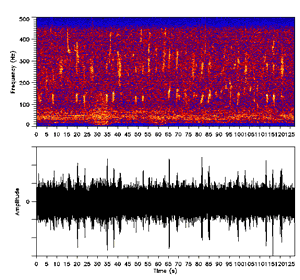Bioacoustics
Bioacoustics is the scientific study of the sound production, dispersion, and reception in animals, including humans. This interdisciplinary field combines biology and acoustics to understand how and why animals communicate with sound, the mechanisms of sound production, and the role of sound in the ecological and evolutionary processes. Bioacoustics encompasses research on all forms of animal life, from insects to marine mammals, and investigates a wide range of topics such as animal behavior, species identification, ecosystem health, and the impacts of noise pollution.
Overview
Bioacoustics involves the analysis of acoustic signals produced by animals, including their structure, function, and ecological significance. These signals can serve various purposes, such as attracting mates, deterring predators, navigating, or locating prey. Researchers in bioacoustics use a variety of tools and techniques, including microphones, hydrophones, and audio recording devices, to capture animal sounds. Advanced software is then used for sound analysis, helping scientists to visualize and interpret the complex patterns of animal communication.
Applications
The applications of bioacoustics are diverse and have significant implications for conservation biology, wildlife management, and environmental monitoring. For example, bioacoustic methods are used in:
- Species Monitoring: Identifying and monitoring species through their unique sounds, which is especially useful for nocturnal or elusive animals.
- Biodiversity Assessment: Assessing the health and diversity of ecosystems by analyzing the acoustic environment or soundscape.
- Behavioral Studies: Understanding the behavioral context of animal sounds, including mating rituals, territory defense, and social interactions.
- Noise Pollution Impact: Studying the effects of human-made noise on animal communication and behavior, which is critical for developing strategies to mitigate these impacts.
Challenges and Future Directions
One of the main challenges in bioacoustics is the vast amount of data generated from sound recordings, which requires substantial computational resources and sophisticated algorithms for analysis. The development of automated sound identification and classification systems is an area of active research, aiming to improve the efficiency and accuracy of bioacoustic studies.
Future directions in bioacoustics may involve the integration of artificial intelligence and machine learning techniques to handle the complexity of acoustic data. Additionally, there is a growing interest in exploring the potential of bioacoustics for understanding the effects of climate change on animal communication and for the development of new technologies inspired by animal sound production and reception mechanisms.
See Also
Transform your life with W8MD's budget GLP-1 injections from $125.
W8MD offers a medical weight loss program to lose weight in Philadelphia. Our physician-supervised medical weight loss provides:
- Most insurances accepted or discounted self-pay rates. We will obtain insurance prior authorizations if needed.
- Generic GLP1 weight loss injections from $125 for the starting dose.
- Also offer prescription weight loss medications including Phentermine, Qsymia, Diethylpropion, Contrave etc.
NYC weight loss doctor appointments
Start your NYC weight loss journey today at our NYC medical weight loss and Philadelphia medical weight loss clinics.
- Call 718-946-5500 to lose weight in NYC or for medical weight loss in Philadelphia 215-676-2334.
- Tags:NYC medical weight loss, Philadelphia lose weight Zepbound NYC, Budget GLP1 weight loss injections, Wegovy Philadelphia, Wegovy NYC, Philadelphia medical weight loss, Brookly weight loss and Wegovy NYC
|
WikiMD's Wellness Encyclopedia |
| Let Food Be Thy Medicine Medicine Thy Food - Hippocrates |
Medical Disclaimer: WikiMD is not a substitute for professional medical advice. The information on WikiMD is provided as an information resource only, may be incorrect, outdated or misleading, and is not to be used or relied on for any diagnostic or treatment purposes. Please consult your health care provider before making any healthcare decisions or for guidance about a specific medical condition. WikiMD expressly disclaims responsibility, and shall have no liability, for any damages, loss, injury, or liability whatsoever suffered as a result of your reliance on the information contained in this site. By visiting this site you agree to the foregoing terms and conditions, which may from time to time be changed or supplemented by WikiMD. If you do not agree to the foregoing terms and conditions, you should not enter or use this site. See full disclaimer.
Credits:Most images are courtesy of Wikimedia commons, and templates, categories Wikipedia, licensed under CC BY SA or similar.
Contributors: Prab R. Tumpati, MD





